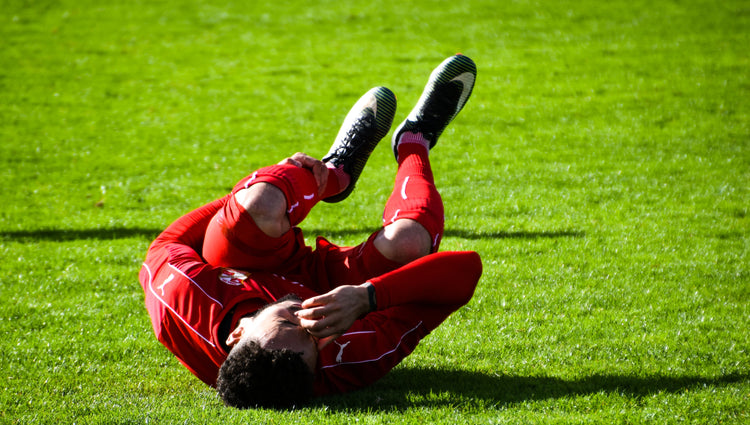The 4 Most Common Injuries in Sports
Kevin Ware, Joe Theismann, Anderson Silva, the history of athletics is filled with examples of famous careers blighted by devastating injuries. But even without the eye-catching images and blaring headlines, regular games of pick-up basketball or Sunday soccer leagues can still contribute to their share of spills, sprains and breaks for the regular athlete.
If you’re currently feeling the pain as a result of your love for the game, or you suspect that nasty twinge in your hamstring might force you out of commission longer than you would hope, then you’re familiar with the story. With KneeRover®, we look to provide you with the best medically aided mobility devices on the market. With its scooter-like design, this knee walker is a great alternative to crutches that lets you remain active even with a fractured leg.
For the sports enthusiasts out there, here are a few injuries you should be on the lookout for.
Knee Injuries
Most movements place a strong load on your knees, from balancing, running to jumping and sliding if you’re on the go then you’re stressing these joints. The statistics bear it out too showing that 55% of all sports injuries and a fourth of all orthopedic treatments are performed on the knee, that’s over 5 million people every year.
The most dreaded form these injuries usually take is an ACL or an MCL tear. Common in soccer, basketball and football, these rip to the ligaments are usually caused by sudden movements such as twists, dodges, or landing after jumps. Usually a tear is followed by a loud popping noise, swelling and eventually difficulty in walking with extreme sensitivity across the entire line of the joint.
The main worry when recovering from these surgeries is being pushed back into action too soon which can see re-injury occur at the rate of 30% within 24 months. Serious injuries such as torn ACL or damage to knee cartilage can hamper the long-term speed and mobility of an athlete, possibly cutting short their playing days.
Ankle Sprain
The ankle is another part of the body that’s necessary for jumping, running or turning, which is why you’ll see so many of these types of injuries crop up in soccer, basketball and volleyball that involve a lot of each. Usually symptoms of an ankle sprain will include pain around the ankle, followed by swelling either immediately or during the next 48 hours after the sprained ankle.
Sprained ankles are graded by severity, and classified as either Grade 1, 2 or 3. A mild injury will usually involve some pain, but very minor swelling. Usually you won’t notice anything wrong until after the game is over and even then you’ll still be able to walk or run, though with some degree of difficulty. In these cases the ligament is usually torn but not stretched. Recovery can take anywhere from 2 to 4 weeks.
Moderate to traumatic injuries will usually present severe pain immediately, with bruising and swelling coming soon after. You’ll either be limping heavily or unable to walk at all, and will most certainly not be finishing your game. Depending on the specific injury you may have torn several ligaments or even broken a bone, and recovery can last anywhere from 4 weeks to 3 months. If that is the unfortunate case, then a KneeRover® can help you avoid further damage, by providing a mobility solution that will let you stay on the move.
Shin Splints
Less debilitating but no less frustrating, shin splints are usually the result of overworking your muscles and tendons. This overuse causes inflammation in your muscles, tendons and the thin tissue covering your shin region. Any sport with constant pounding motions and stress being placed on the lower joints and muscles of your body sees many occurrences of this type of injury; runners and soccer, tennis and basketball players are amongst the most affected.
Rehabilitation usually takes one to several weeks once a fracture has been ruled out. Usually, doctors will recommend plenty of rest, ice and avoiding any sudden strenuous exercise when recovering. With the KneeRover®, you stay active as your shin injury heals, so that when you do return to action, your joints and muscles don’t feel as much of a strain.
Achilles Tendon Rupture
This tendon is a tough band of fibrous tissue that connects the calf muscles to the heel bone. It is the biggest and strongest in your entire body, so it takes a lot to cause a rupture. When it does, it can be devastating for any athlete. The Achilles is responsible for connecting your leg muscles with calf muscles, and any motions which involve you pushing off with the foot, including running and jumping, affect the tendon. Nearly 70% of these types of injuries occur while playing sports, with more than half of them being during basketball, and with the constant impact that jumping places on your body, it’s no surprise either. Achilles tendon injuries will often affect people who are middle-aged or older who play sport recreationally, as their tendons are tighter and less flexible putting them at greater risk of tearing.
Immediately after you experience a rupture, you’ll feel a pain that’s reportedly similar to being shot or stabbed in the back of the leg, and you may even hear a loud pop. Though you may be able to finish off your game hobbling around, you will not be able to generate any power on jumps. Immediate treatment involves rest and plenty of ice. The results of the injury can require months of recuperation and time away from any strenuous activity. A knee scooter from KneeRover will allow you to stay on the move while you follow the doctor’s orders. Our ergonomically designed device stops you having to bear any weight on affected areas while still providing you with mobility and functionality inside and outside.
No matter what the injury or how severe, you can rest assured that you don’t have to stay confined to the couch anymore. The KneeRover® is a medical aid that provides all the functionality of crutches with none of the aches and pains.

